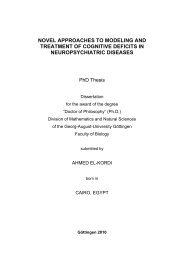Cortical and subcortical mechanisms in persistent stuttering ...
Cortical and subcortical mechanisms in persistent stuttering ...
Cortical and subcortical mechanisms in persistent stuttering ...
You also want an ePaper? Increase the reach of your titles
YUMPU automatically turns print PDFs into web optimized ePapers that Google loves.
Chapter 1 Introduction<br />
al., 2004). A direct test of the role of right-hemispheric motor areas to proposed specific<br />
behaviors is so far miss<strong>in</strong>g <strong>in</strong> stutter<strong>in</strong>g research.<br />
In the first study of the current dissertation TMS was used to <strong>in</strong>duce a virtual lesion <strong>in</strong> the<br />
dorsolateral premotor cortex (PMd) to test its role <strong>in</strong> movement tim<strong>in</strong>g <strong>in</strong> persons who stutter.<br />
In healthy subjects it has been reported that the left PMd is crucially <strong>in</strong>volved <strong>in</strong> the control of<br />
paced f<strong>in</strong>ger movements (Pollok et al., 2008). It is unclear whether this cortical lateralization<br />
of tim<strong>in</strong>g control holds true <strong>in</strong> persons who stutter. Support<strong>in</strong>g evidence for an imbalanced<br />
functional lateralization of the control of f<strong>in</strong>ger tapp<strong>in</strong>g <strong>in</strong> stutter<strong>in</strong>g is given by a recent fMRI<br />
study (Morgan et al., 2008). While <strong>in</strong> healthy subjects f<strong>in</strong>ger tapp<strong>in</strong>g with the right h<strong>and</strong><br />
activated the contralateral motor <strong>and</strong> premotor cortex, <strong>in</strong> persons who stutter the precentral<br />
gyrus of either hemisphere was activated. In the study presented here we tested whether the<br />
right premotor cortex is <strong>in</strong>deed functionally <strong>in</strong>volved <strong>in</strong> a paced f<strong>in</strong>ger tapp<strong>in</strong>g task <strong>in</strong> persons<br />
who stutter.<br />
The second study <strong>in</strong>cluded <strong>in</strong> this dissertation took aim at the neurophysiological <strong>mechanisms</strong><br />
<strong>in</strong> the primary motor tongue representation. From a neurophysiological po<strong>in</strong>t of view, the<br />
right hemispheric hyperactivity of the primary motor cortex dur<strong>in</strong>g symptom production<br />
(Braun et al., 1997; Fox et al., 1996; Fox et al., 2000) has been <strong>in</strong>terpreted as <strong>in</strong>creased<br />
cortical excitability (Ludlow <strong>and</strong> Loucks, 2003). By apply<strong>in</strong>g TMS it is possible to determ<strong>in</strong>e<br />
cortical excitability (see Appendix D). Although TMS is well established <strong>and</strong> a widely used<br />
technique there are only two reports on cortical excitability <strong>in</strong> stutter<strong>in</strong>g research preced<strong>in</strong>g<br />
this dissertation (Sommer et al., 2009a; Sommer et al., 2003). The objective of the most recent<br />
study (Sommer et al., 2009a) is to elucidate transcallosal <strong>in</strong>teractions between the motor<br />
cortices <strong>in</strong> adults who stutter. The <strong>in</strong>terplay between hemispheres which is operationalized<br />
with measures of transcallosal <strong>in</strong>hibition <strong>and</strong> ipsilateral silent period was normal <strong>in</strong> the<br />
cortical h<strong>and</strong> representation <strong>in</strong> stutter<strong>in</strong>g, not <strong>in</strong>dicat<strong>in</strong>g that this <strong>in</strong>terplay between motor<br />
cortices is likely to play a decisive role <strong>in</strong> stutter<strong>in</strong>g. The earlier study (Sommer et al., 2003)<br />
ascerta<strong>in</strong>s the <strong>in</strong>tracortical excitability of the cortical representation of a right h<strong>and</strong>. The<br />
critical parameters are <strong>in</strong>tracortical <strong>in</strong>hibition which is likely mediated by <strong>in</strong>hibitory motor<br />
cortical <strong>in</strong>terneurons (Hallett, 2000), <strong>and</strong> <strong>in</strong>tracortical facilitation which is hypothesized to be<br />
a net facilitation consist<strong>in</strong>g of prevail<strong>in</strong>g facilitation <strong>and</strong> weaker <strong>in</strong>hibition mediated, among<br />
other <strong>mechanisms</strong>, by glutamatergic N-methyl-D-aspartate (NMDA) receptors <strong>and</strong> γ-<br />
Am<strong>in</strong>obutyric acid (GABA)ergic receptors (Hanajima <strong>and</strong> Ugawa, 2008; Paulus et al., 2008).<br />
Aga<strong>in</strong>, <strong>in</strong>tracortical <strong>in</strong>hibition <strong>and</strong> <strong>in</strong>tracortical facilitation were found to be normal <strong>in</strong> the<br />
19



